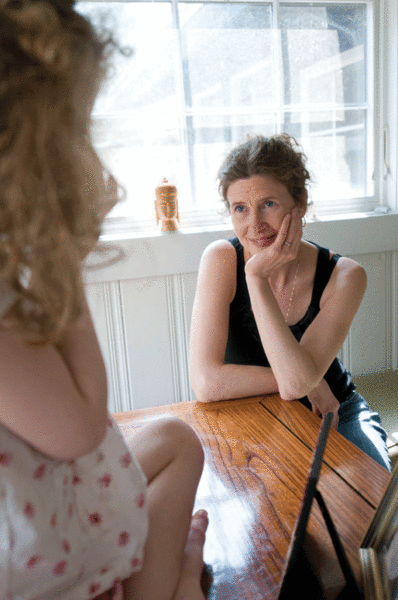Flowers Fall: August 2012
Looking at Humans is Fun: An Interview with Anthony Graesch
[]
If you are looking for a juicy bit of social science to peruse during your kids’ swim lesson, look no further. Life at Home in the Twenty-first Century: 32 Families Open their Doors, part of a long-running study at UCLA’s Center on Everyday Lives of Families, is the perfect way to gear up for the porch-party chit chat later in the day. You can surprise your hosts with educated factoids about how much time it actually takes to make a from-scratch meal vs. a packaged one (12 minutes), and then tell them all kinds of things they already know, like the fact that by measuring cortisol levels, researchers found that women’s stress-levels spike when showing researchers around particularly cluttered areas. And men’s? Not so much.
The book is by Jeanne E. Arnold, Anthony P. Graesch, Enzo Ragazzini, and Elinor Ochs, and is published by the Cotsen Institute of Archaeology at UCLA. I had the pleasure of chatting with Professor Graesch about the book. It was a hoot talking to such a neutral science guy about the stuff that gets me all worked up. He says, for instance, that “It’s hard to moralize about any individual way of being human.” Of course he’s right, but hey, you can’t blame a girl for trying!
I understand you were childless and recently married when you did this work. Did this foray into family life freak you out?
Anthony Graesch: [Laughs.] Definitely. Having been enjoying all the freedoms of being a married adult without children—which I vaguely remember—it was sort of a slap in the face. You never can really empathize with parenting in a dual-income household until you’re confronted with it on a daily basis. As I told a reporter at the New York Times, this is a very potent form of birth control.
You have two small children now. So what changed?
I think learning how to parse out information. While sitting around in our weekly meetings when the full research team got together, 20 to 30 people from different disciplines, [and ] we would watch video clips of families, and we would look for patterns. It was a way for me to begin to parse out otherwise complex behavior and to really understand what was going on. So at the surface one might see some pretty stressed families, and sometimes very tense interactions, but once I started to get a handle on what was unfolding and maybe why it was unfolding, I think it sort of made it—less freaky, if you will.
While the tone of the book is generous, it is also quite damning.
It is quite damning, but there’s [also] an incredible amount of warmth in these families, and positive and loving interactions.
I am personally very intrigued by the choices we make, and where they come from. We so often take our so-called “busy lives” as an assumption. After spending all this time with these families, do you think it could be different?
It could always be different, but breaking out of these patterns is difficult. Not only are we busier, and living in this culture of “busy-ness,” but we’re further away from loved ones as well, physically, from our social networks, the village that would otherwise help raise those children. To some extent, the “busy household” is also a marker of middle-class success. We are in an era where we place extraordinarily high value on children gaining higher education. To some extent, children are working harder now than when they were working in factories. In the pursuit of more and more selective colleges, they have to do more music, more sports, more everything. We place children as representing the success of our household, and as markers of our own status, and it all creates busy-ness.
Right, and all the stuff we buy is certainly not necessary.
Exactly. When my son turned one year old, and we were in the heart of this project, I put him on the floor and surrounded him with all his possessions and enumerated them. It was maybe 85 to 100 things. And then when he turned two, the number had nearly quadrupled. Very little of it was our purchases. Stuff just comes in. My wife and I have come to think of different rituals for getting rid of stuff.
From my point of view, much of what you point to in the book is part of the massive suffering in our culture—the lack of time, the stuff, eating super processed foods, being plugged in—I look at it all and see a large-scale spiritual crisis.
Which is certainly possible. But that requires us to elevate what came before as a more enlightened way of living.
Okay, here’s a quote from the book: “Children choose indoor activities for about 90 percent of their leisure time at home, dominated by TV, video games, play with toys and puzzles, and general play with siblings and friends. Much of this play is sedentary and solitary. Outdoor pools, sports equipment, and expansive grassy yards are rarely used. Some families keep blinds and curtains perpetually closed.” Can this possibly be a good thing?
It’s tough for me to moralize about this. The reality of the data is we don’t know the effects of, say, television with respect to, for instance, social cohesion or cognitive development. There are a lot of interesting suggestions out there, but it’s a moving target, which I think is neat.
But do you really buy that, I mean, come on.
I think Americans have come to internalize the belief that television rots the brain. We found that when families came together around the TV there was actually a lot more social interaction.
Did people seem happy?
A lot of variability there. I am trying not to be that guy who avoids committing to anything, but sometimes it varies by the day and the family. There were a lot of warm moments out there, incredibly loving moments and socially cohesive moments, and a lot of incredibly tense moments as well, as you would expect. All of these things, we were there for just this little slice of time. I am happier this month that I was last month. Why is that?
Right. Being human is a quite a ride.
There are fundamentally different ways of being human. It’s hard to moralize about any individual way of being human, but it is fun to look at them in all their variability.
Check out Bethany’s latest writing adventure, “Is This My Chair? Notes on Being,” a blog at
Isthismychair.com.












